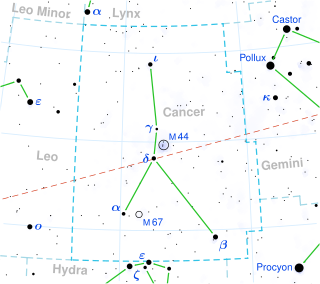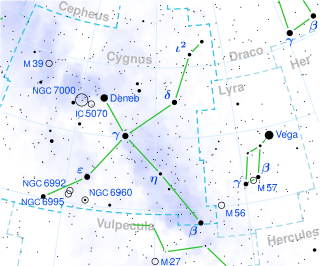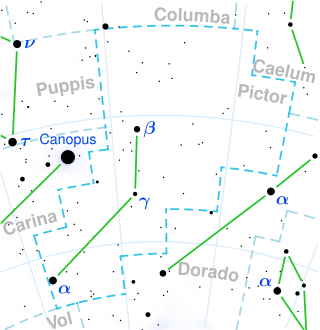
Beta Cancri, also named Tarf, is the brightest star in the zodiacal constellation of Cancer. It has an apparent visual magnitude of +3.5 and an absolute magnitude of −1.2. Based on parallax measurements obtained during the Hipparcos mission, it is approximately 290 light-years distant from the Sun. An exoplanet, designated Beta Cancri b, is believed to be orbiting the star.

Omicron Velorum is a star in the constellation Vela. It is the brightest member of the loose naked eye open cluster IC 2391, also known as the ο Velorum Cluster.

Tau Pegasi, formally named Salm, is a magnitude 4.6 star 162 light years away in the constellation of Pegasus. With about twice the mass of the Sun and thirty times as luminous, it is a δ Scuti variable star with its brightness changing by a few hundredths of a magnitude over about an hour.

HR 6801 is a single star in the southern zodiac constellation of Sagittarius. It was designated as 1 Sagittarii by Flamsteed, but is now often referred to as 11 Sagittarii. Flamsteed's 11 Sgr actually refers to a different, much fainter star. The object is orange in hue and is visible to the naked eye as a faint point of light with an apparent visual magnitude of 4.96. The distance to this star is approximately 258 light years based on stellar parallax, and it is drifting further away with a radial velocity of +6 km/s.

Epsilon Microscopii, Latinized from ε Microscopii, is a single, white-hued star in the southern constellationof Microscopium. It is faintly visible to the naked eye with an apparent visual magnitude of 4.71. The annual parallax shift of the star is 19.7054 mas as measured from Earth, which yields a distance estimate of around 166 light years. It is moving further from the Sun with a radial velocity of +7 km/s.

31 Orionis is a binary star system in the equatorial constellation of Orion, located near the bright star Mintaka. It is visible to the naked eye as a faint, orange-hued point of light with a baseline apparent visual magnitude of 4.71. The distance to this system is approximately 490 light years away based on parallax, and it is drifting further away with a mean radial velocity of +6 km/s.

22 Orionis is a binary star in the equatorial constellation of Orion. It has the Bayer designation o Orionis, while 22 Orionis is the Flamsteed designation. This system is visible to the naked eye as a faint, blue-white hued star with an apparent visual magnitude of 4.74. It is located approximately 1,100 light years away from the Sun based on parallax. The system is moving further from the Earth with a heliocentric radial velocity of +28.80

51 Orionis is a single star in the equatorial constellation of Orion. It has the Bayer designation b Orionis, while 51 Orionis is the Flamsteed designation. This object is visible to the naked eye as a faint, orange-hued star with an apparent visual magnitude of 4.90. It is located approximately 299 light-years away from the Sun based on parallax, and is drifting further away with a radial velocity of +88 km/s.

4 Persei is a single star in the northern constellation of Perseus, located around 670 light years away from the Sun. It is visible to the naked eye as a faint, blue-white hued star with an apparent visual magnitude of 5.04 The Bayer designation for this star is g Persei; 4 Persei is the Flamsteed designation. This object has a peculiar velocity of 26.3 km/s and may be a runaway star.

NV Puppis, also known as υ1 Puppis, is a class B2V star in the constellation Puppis. Its apparent magnitude is 4.67 and it is approximately 800 light years away based on parallax.

OU Puppis is a chemically peculiar class A0 star in the constellation Puppis. Its apparent magnitude is about 4.9 and it is approximately 188 light-years away based on parallax.

HD 61772 is a bright giant star in the constellation Puppis. Its apparent magnitude is 4.98 and it is approximately 660 light years away based on parallax.

43 Sagittarii is a single star in the southern constellation of Sagittarius. It has the Bayer designation d Sagittarii, while 43 Sagittarii is the Flamsteed designation. This object is visible to the naked eye as a faint, yellow-hued star with an apparent visual magnitude of 4.88. From parallax measurements, it is estimated to lie around 470 light years away from the Sun. The star is drifting further from the Earth with a heliocentric radial velocity of +15.2 km/s. It is located near the ecliptic and thus is subject to lunar occultations.

9 Persei is a single variable star in the northern constellation Perseus, located around 4,300 light years away from the Sun. It has the Bayer designation i Persei; 9 Persei is the Flamsteed designation. This body is visible to the naked eye as a faint, white-hued star with an apparent visual magnitude of about 5.2. It is moving closer to the Sun with a heliocentric radial velocity of −15.2 km/s. The star is a member of the Perseus OB1 association of co-moving stars.

42 Persei is a binary star system in the northern constellation of Perseus. It has the Bayer designation n Persei, while 42 Persei is the Flamsteed designation. The system is visible to the naked eye as a dim, white-hued point of light with an apparent visual magnitude of 5.11. It is located around 93 parsecs (302 ly) distant from the Sun, but is drifting closer with a radial velocity of −12.4 km/s.

31 Cygni, also known as ο1 Cygni, Omicron1 Cygni, ο2 Cygni or V695 Cygni, is a ternary star system about 750 light years away in the constellation Cygnus.

HD 42540, also known as HR 2196, is a giant star in the constellation Pictor. A class K2-3III orange giant, its apparent magnitude is 5.04 and it is approximately 389 light years away based on parallax.

NW Puppis, also known as υ2 Puppis, is a star in the constellation Puppis. Located around 910 light-years distant, it shines with a luminosity approximately 1,108 times that of the Sun and has a surface temperature of 15,000 K.

The Bayer designation ζ Librae, Latinised as Zeta Librae is shared by several star systems in the constellation Libra. Sources differ about the Flamsteed and Bayer designations that should be applied to four stars:

72 Tauri is a possible binary star in the zodiac constellation of Taurus. It is faintly visible to the naked eye with an apparent visual magnitude of +5.5, although only 0.29° from the brighter υ Tauri. Based upon an annual parallax shift of 7.9 mas seen from Earth, it is around 410 light years from the Sun.













